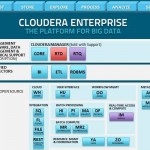What’s the best way to follow up a week of Oracle OpenWorld? Cloudera Developer Training for Apache Hadoop of course.
So today I had my first day. I won’t detail the course itself (though I hope there will be many Hadoop posts to come). But I would like to share three of the things I learned today.
DISCLAIMER: I’d like to stress that I learned these things today. If anything in this blog post is factually inaccurate please calmly proceed to the comments section and let me know so I can fix it and learn more. Or if you’re having a bad day and need to vent you can give me the ol’ what for. I can take it.
The Famous Word Count Reducer Example Sets a Weak Tone
This isn’t about the course, but what you’ll find on the web with regards to Hadoop and MapReduce. Usually when you’re looking up MapReduce examples the first thing you’ll find is one with a list of fruit or animals or something else and an example of how a MapReduce job can find the number of occurrences of each word and then sum up the counts per word. So for instance:
Input
apple banana apple orange
banana orange apple apple
apple banana banana
Mapper
- Accept the input as key:value pairs (key is the character position number of each newline, value is each line)
- Loop through the array of key:line pairs
- Emit key:value pairs of words as keys, and ‘1’ as value for each time it shows up
So in this case it would emit something like [apple:1, banana:1, apple:1, orange:1, banana:1, orange:1, apple:1, apple:1, apple:1, banana:1, banana:1].
Reducer
- Accept the input of key:value pairs (words and the number ‘1’ for each occurrence)
- Loop through the input array
- Sum up the 1’s (value) per word (key)
- Return the results for the final hoorah
In this case, the final output would be [apple:5,banana:4,orange:2]
Simple, right? The problem for me is that it doesn’t capture the complexity and power of Hadoop and MapReduce well enough. I get that this is like the ‘Hello World’ of MapReduce jobs. But I still feel it sets a weak tone compared to other software packages I’ve seen, particularly to beginners. Where’s the excitement of a dozen or more DataNodes churning through the Map phase? Where’s the promise of a medical and espionage technological revolution I’ve heard so much about? Where, pray tell, is the big data?
Remember that MapReduce jobs can be written in many different languages (Java is the original but not the only one) and can use all the tools of that language. If you’re writing in Java and want to parse text, go for it.  If you want to convert image formats and keep track of sizes or conversion time, feel free. If you’re writing in PHP or node.js or Python and want to pull extra information from webservices to compare against, be my guest (but don’t bottleneck your job). These Mapper and Reducer classes are generally small and lightweight, but remember that you can do any programming magic you desire in them. It’s up to you and your imagination.
If you want to convert image formats and keep track of sizes or conversion time, feel free. If you’re writing in PHP or node.js or Python and want to pull extra information from webservices to compare against, be my guest (but don’t bottleneck your job). These Mapper and Reducer classes are generally small and lightweight, but remember that you can do any programming magic you desire in them. It’s up to you and your imagination.
That being said, the Cloudera Quick Start VM is awesome. It’s free to download and comes preconfigured with Cloudera Manager, HDFS, Hive, Hue, MapReduce, Oozie, ZooKeeper, Flume, HBase, Cloudera Impala, Cloudera Search, and YARN. It even comes with example queries and scripts. If you’re really wanting to find out what Hadoop and MapReduce are about, I’d recommend starting with it.
Hadoop Can Be Fairly Breakable
While Hadoop is awesome in its ability to scale and provide fault tolerance at the DataNode level through block replication, the overall system is fairly weak thanks to the single points of failure on the NameNode. The NameNode itself is a single point of failure, though Hadoop 0.23 and higher can have a Secondary NameNode. On the NameNode comes the JobTracker which is also a single point of failure. However, from what I understand MapReduce 2 will help alleviate that a bit.
 Also, even though you use the Hadoop Filesystem (HDFS) for putting and getting data, that filesystem is really just a virtual filesystem over a share-nothing cluster of local filesystems on your DataNodes. Even though access into the HDFS files is governed by the ‘hadoop’ binary or other APIs, you can log into a DataNode and remove data blocks fairly easily. I’m not saying this is a flaw; hell, you could do the same with Oracle, where any ‘dba’ user can overwrite and tear up a database. In fact, Oracle is more susceptible due to the lack of block replication. But it’s still worth noting.
Also, even though you use the Hadoop Filesystem (HDFS) for putting and getting data, that filesystem is really just a virtual filesystem over a share-nothing cluster of local filesystems on your DataNodes. Even though access into the HDFS files is governed by the ‘hadoop’ binary or other APIs, you can log into a DataNode and remove data blocks fairly easily. I’m not saying this is a flaw; hell, you could do the same with Oracle, where any ‘dba’ user can overwrite and tear up a database. In fact, Oracle is more susceptible due to the lack of block replication. But it’s still worth noting.
Third is security. By default the security of writing and running jobs in Hadoop sucks. If you really want good security you need to configure it with kerberos. Apparently this has been well discussed.
Hadoop is Just the Beginning
 Being the horrible student that I am, I took some time to delve into other software on my first day such as Hue, Hive, HBase, and Pig. Hue is pretty awesome as a UI to the ecosystem as a whole, not much to say there. But looking at Hive and Pig specifically, tinkering a bit with some PigLatin, and playing with some sample data in Hive got me realizing that understanding HDFS and MapReduce are things I really need to do…so I can move onto learning more.
Being the horrible student that I am, I took some time to delve into other software on my first day such as Hue, Hive, HBase, and Pig. Hue is pretty awesome as a UI to the ecosystem as a whole, not much to say there. But looking at Hive and Pig specifically, tinkering a bit with some PigLatin, and playing with some sample data in Hive got me realizing that understanding HDFS and MapReduce are things I really need to do…so I can move onto learning more.
My current set of goals are to finish the course, take my Cloudera Certified Developer for Apache Hadoop (CCDH) exam, and starting learning Pig and Mahout. However, from what I can tell this will be my favorite kind of learning experience: one with a twist at every new finding. The kind of weekend project that turns into a week project, then multi-week, then consumes you until you realize, “Hey, I know this crap.”
Wish me luck.


Nice blog| I have gained good knowledge about Hadoop.
Nice article, it is very valuable helpful and informative for me. Thanks for sharing these information with all of us.
Bigg Boss 17th season will go on the floor day from 3 October 2023. The online application form
Following the format of the show, Bigg Boss 17 celebrity contestants will be locked in a house.
absolutely loved it.thanks
Comprar carta de condução
Work hard and get up top…. https://kupie-prawo-jazdy.com/
Get it done really fast… https://kupiprawojazdy.com/
All in one, we can get there with more effort… https://comprar-carnet-deconducir.com/
No sleep i do only naps… https://koupi-tridicskyprukaz.com/
Give it up for the one in form now… https://geregistreerdrijbewijskopen.com/
Help get it all the way to the top… https://acheter-permis-de-conduire.com/
let’s try that again this time with more pressure… https://kupiti-vozaku-dozvolu.com/
Try a different approach to this problem… https://comprar-cartadeconducao.com/
Just work a little bit harder than before…. https://acquistapatentediguida.com/
The same process all through but a different approach…. https://comprare-la-patente.com/
Make it make sense to me, we are going all out…. https://kjopeforerkort.com/
Let us try to make things go smoothly… https://dokumenteanzeigen.com/